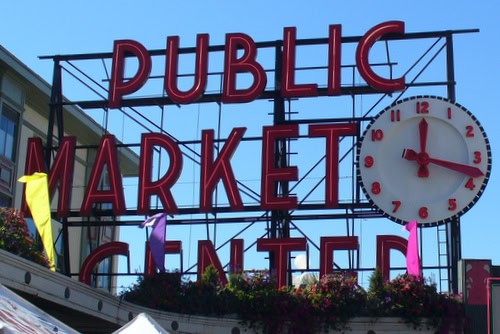Here’s our list of popular u-pick fruits, berries, and vegetables and the best month to pick them in the Seattle-Tacoma metro area and Western Washington counties around the Puget Sound region. In addition, we provide a link to a map of u-pick farms near you for each crop.
Washington State is known worldwide for large commercial crops of apples and potatoes. However, many other fruits and vegetables are grown here. Some popular u-pick crops include strawberries, blueberries, cherries, pumpkins, and many more. Find a month-by-month schedule of the peak u-pick season for each crop below.
You can pick locally grown fruits, berries, and vegetables to eat fresh, as well as preserve some for your pantry to enjoy through the winter months.
Tip: If you are originally from the southeast or southwest United States, you will find the growing seasons in Washington State to be later than what you are used to—about one month or later, sometimes more.
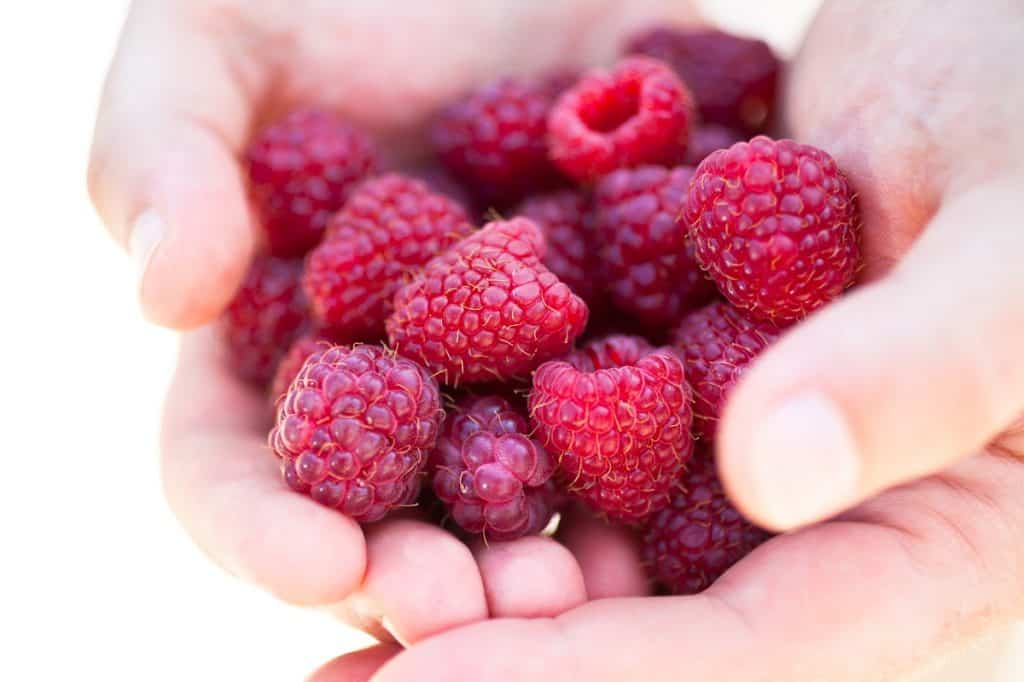
Nothing says summer like a handful of fresh berries, one of Washington States most popular u-pick crops. Local berries include strawberries, blackberries, blueberries, and raspberries (pictured above) – Image via DepositPhotos.com
About Puget Sound Fresh
The Puget Sound region supports a diversity of fresh fruits and vegetables, meats, poultry, fish and shellfish, eggs, herbs, flowers and a wide variety of value added-farm products such as preserves, ciders and wine, cheese.
Tilth Alliance was created to assist Washington State farmers in the 12 counties that surround Puget Sound. They help small farms market their products, keep farmland in production, and encourage the development of new farm enterprises.
A great resource is the Washington Food & Farm Finder (it’s an enormous map of resources that takes a bit of time to load, so give it some time). It’s your best source for what’s fresh, local and in season in Washington State. When you use the WA Food Finder to find local farms and farmer’s markets, you ensure that our states farms and local businesses that we rely on to produce our food remain healthy businesses year after growing year. Please support them.
What fruits and vegetables are available for u-pick?
Listed below is a list of the most popular u-pick produce in Western Washington and their season for u-pick. Of course, Mother Nature can play with crop dates. In some years, the growing season can start later or end early. Scroll down for a list of suggested Month-by-month U-Pick Fruits & Vegetables when they are in peak season.
- apples (Sep-Nov)
- apricots (Jun-Aug)
- blackberries (Jun-Aug)
- blueberries (Jul-Sep)
- cherries (Jun-Sep)
- corn (Jul-Oct)
- grapes (Aug-Nov)
- green beans (Jul-Oct)
- peaches (Jun-Sep)
- pie pumpkins and winter squash (Oct-Dec)
- raspberries (Jun-Aug)
- strawberries (May-Sep)
- tomatoes (Jul-Nov)
For a list what’s in season each month in Washington State, check out this Vegetable Season Chart (PDF) and Fruit, Herb, & Legume Season Chart (PDF) from Washington State Department of Agriculture.
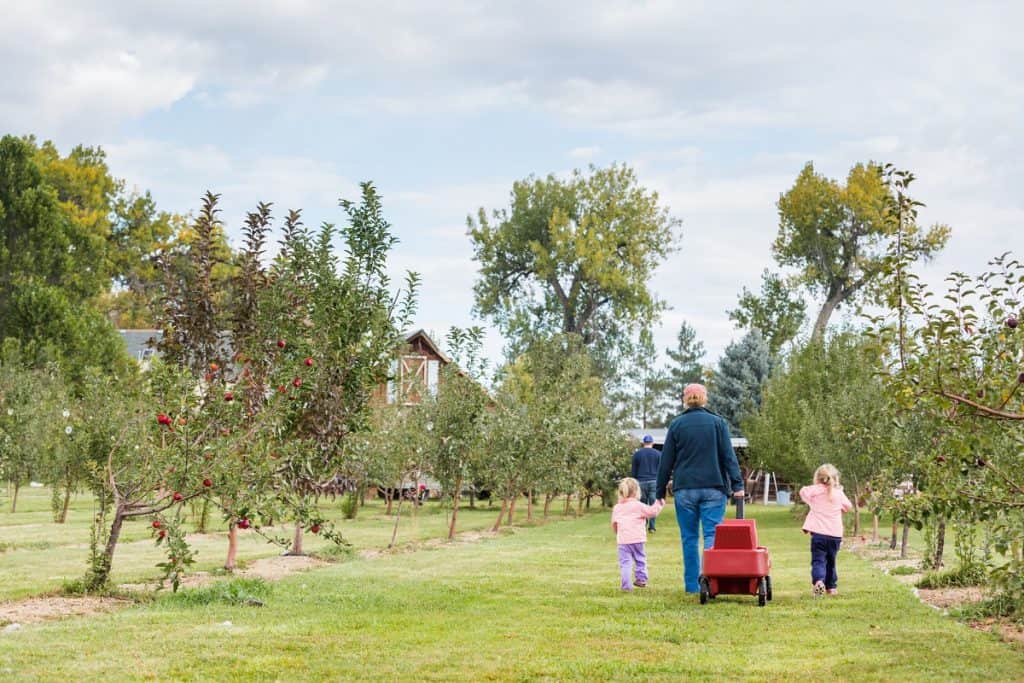
Young family strolling a u-pick apple farm – DepositPhotos.com
Tips for successful u-pick outings
Read through the following u-pick tips. We include suggestions for before, during, and after your u-pick adventure. These tips will help get prepared before your first u-pick outing or as a checklist for any outing even when you’ve been before.
Before you go u-pick
What are the benefits of u-pick? It’s worth noting that the reason for u-pick is not always an economic one. Often the price you pay at u-pick farms is less than what you’d pay at a grocery, farmer market, or the farm stand. But not always. If saving money is your goal, you might want to start a vegetable garden. However, there are several other benefits to u-pick:
- U-pick makes a great family outing.
- Get outside and enjoy clean country air.
- Support the local farm economy.
- Find crop varieties not available at grocers.
- Pick and prepare or preserve local produce to ensure exactly what is in your food.
How much to pick? Err on the side of picking too little, rather than too much. If you overestimate, you end up wasting food. Wasted food won’t save you money in the long run. Plan on picking no more than 10 pounds of any crop unless or until you’ve determined if your needs are higher.
There’s an old saying “a pint is a pound the world around”.
This means for every pound of produce you can estimate one pint (2 cups) of canned or frozen food, or about four servings. While individual crops can vary from this “a pint is a pound” estimate (sometimes by quite a bit), picking two to five pounds of any crop is a good starting point for newcomers.
The average home canner only preserves 10 pints of any given food, often much less. That’s just 10 pounds of produce.
People new to u-pick are often tempted by a good deal on a box of produce. But a box or case might weigh 20 to 40 pounds. Think twice about buying that much produce!
Start with easy crops to pick. If you are new to u-pick, or if you are bringing young children along, stick with crops that are easier to pick. Start with a small amount, less than five pounds for most crops. The easiest crops to pick include firm berries and fruits, such as blueberries, pears, and of course, pumpkins (super easy).
Fragile or difficult crops to pick include soft berries and fruits, such as apricots, blackberries, peaches, raspberries, and strawberries.
Getting ready to u-pick
Dress appropriately. Dress in old clothing with long sleeves and pants. Lose, light-colored clothing is most comfortable during mid-summer. Wear a hat with a wide brim or baseball cap and sturdy shoes. Don’t forget insect repellent or sunblock.
Pack for a day-long trip. Bring water, snacks, and disposable wipes or hand towels. Another item you may want to bring is a camera or smartphone to capture a memory of the day.
Leave the pets at home—it’s against regulations on farms and most u-pick locations. It is also forbidden to leave your pets in a hot car while parked on farm property.
Plan to pick early—early in the day when it is cooler and earlier on the weekend. Fields can get picked over by early afternoon or by the end of a busy weekend. Once picked over, farmers may close fields for a day or more to allow more crops to ripen.
ALWAYS call the farm before you head out to be sure their fields are open. Many farms have a phone recording updated each morning or evening letting you know about what’s in the field and ready for picking each day. Some farms may also utilize social media to get the word out about crop status.
Bring containers for picking and hauling your produce home. Unless the farm provides them (some do, some don’t, so be sure to check). In some cases, you are charged for containers unless you bring your own.
Confirm payment methods. Some farms accepts cash only, (credit/debit) cards only, or cashless methods (Venmo, PayPal, etc.). If using cash, bring small bills and some change so you can pay the exact amount.
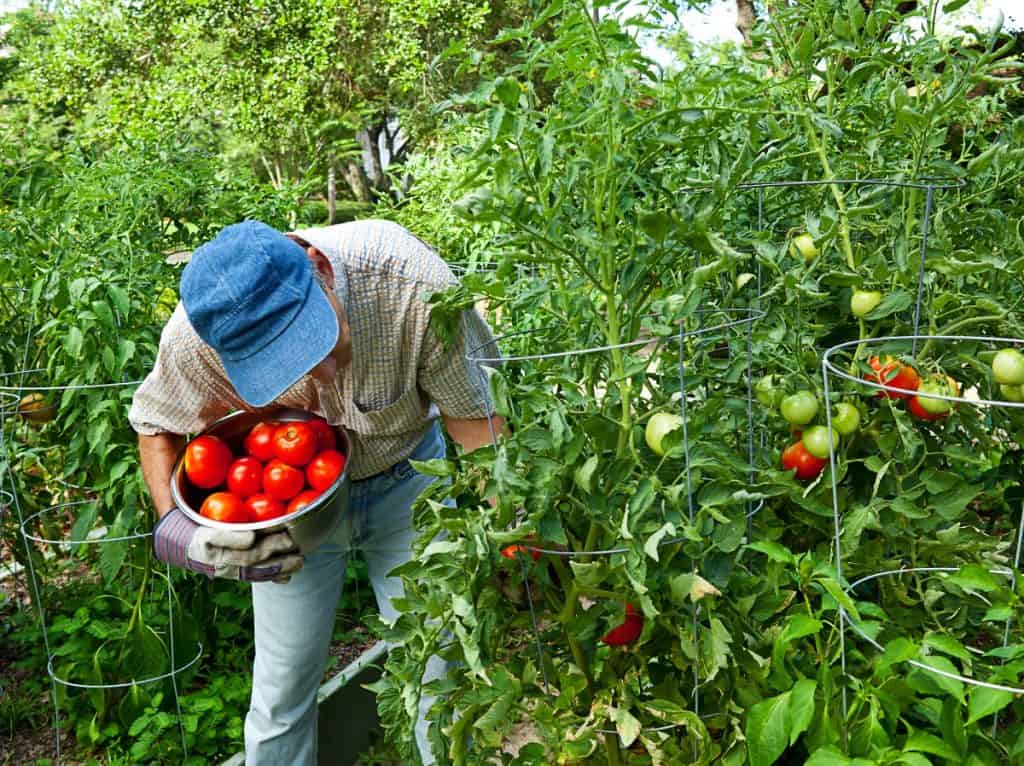
Picking tomatoes from the vine – DepositPhotos.com
At the u-pick farm
Please follow the rules. When you arrive at the farm, be sure to educate yourself, and your children, about any rules posted by the farmer. Some rules that are always good to follow include:
- pick only from the plants you are directed to pick
- pick each plant or tree/branch clean of all ripe produce—don’t just skim the easy-to-reach spots
- walk in-between plants—never step on plants
- stay clear of any farm equipment
- place any trash in the proper receptacle—better yet, if you brought it with you, take it home
Know how charges are calculated. Before you start to pick, confirm whether you are being charged by the weight, by the volume, or by piece. If the cost of the u-pick crop is charged by weight, I always like to ask how much a bucket or a box weighs. Then I make a mental note of how much to pick.
The first time I picked blueberries, I wanted 10 pounds. I picked for an hour or so. When I went up to pay, I had already picked 17 pounds! Thankfully, I love blueberries on my yogurt, so I easily consumed them all before the next growing season. Whew!
After your u-pick adventure
Prepare you produce within 24 hours. Once you get the produce home, prepare it within 24 hours for preserving. You can preserve most fruits and vegetables by freezing, canning, drying, pickling, or fermenting.
Freezing berries is easy to do. Berries are some of the easiest crops to preserve, especially by freezing. (I canned my blueberries, which is fairly easy to do.) Stone fruits and most vegetables take more preparation (peeling, cutting, etcetera).
Keep a record of your crops. After you’ve picked and preserved one crop, try another. Keep a notebook and record how much you picked, how you preserved it. At the beginning of the next season, check your pantry and see what’s left. Do you need more or less this year?
No time to pick? Join a CSA or shop a farmers market
If you want the freshest produce the Puget Sound region has to offer, but don’t have time for u-pick, then get it delivered to a convenient pick-up location during the growing season by joining a Community Supported Agriculture (CSA) program.
What is a CSA? CSA is a very simple agreement between you and a local farmer. It’s much like a magazine subscription. You pay an upfront “subscription fee” directly to the farmer. Each week during the terms of the CSA, the farmer packs a “market-in-a-box” just for you.
Every CSA varies, from the size and contents of the box to the pick-up or delivery location, frequency, length of season, and cost. Besides vegetables, herbs, and fruits, many farms offer CSAs that include other products such as eggs, flowers, meat, preserves, cheese, and more. CSA’s offer something for every size family and a variety of food choices.
- Find a CSA that fits you and your family’s lifestyle.
Alternatively, you can shop at farmers markets in the Puget Sound region where you can buy freshly picked produce close to where you live.
Month-by-month U-Pick Fruits & Vegetables
Listed below is the peak month for picking each crop. But sometimes Mother Nature has a different mindset. Therefore, we recommend that you check u-pick farms one to two months prior to the peak month to find out how this year is shaping up. Some farms have crop status on their website or may have a phone number you can call for information. During the peak growing season, this information may be updated daily.
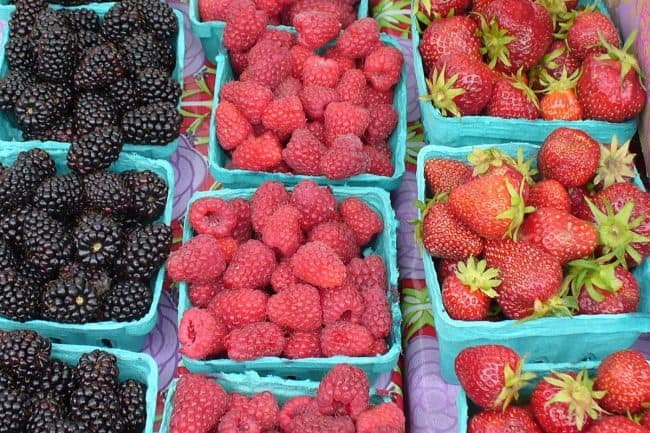
Freshly picked baskets of (L-R) blackberries, raspberries, and strawberries – photo copyright by Carole Cancler
June: strawberries
- To find a u-pick farm near you, use the Washington Farms | Local Farm Finder (eatlocalfirst.org)
June-bearing strawberry season typically peaks in mid-June. However, there are also ever-bearing strawberry varieties that ripen twice, once in early June and again in late summer. Begin calling u-pick strawberry farms mid-April to mid-May for status of the current season, and which varieties they offer for u-pick.
July: apricots, cherries, peaches, raspberries
- To find a u-pick farm near you, use the Washington Farms | Local Farm Finder (eatlocalfirst.org)
Apricots typically peaks in July, however there are many varieties of apricots, some ripening earlier and later. Begin calling u-pick apricot farms in May or June for status of the current season and to plan the ideal time to go.
Cherries (both sweet and tart pie varieties) typically peaks in July. However, there are many types of cherries. First decide if you want sweet or pie cherries (or both), then peruse the farm list for the ones who offer the type you want. Begin calling u-pick cherry farms in May or June for cherry crop status.
Peach season peaks in July or August. There are two main varieties: “cling” and “freestone”. Freestone have a pit that is easy to remove, while cling types, well, cling to the fruit and are harder to cut off. If you are a peach lover, you might want to pick some cling varieties for fresh eating, but choose freestone types if you want to remove the pit for canning or freezing. Call u-pick peach farms any time of year to find out which varieties (cling or freestone) they might have, and again in May or June to get updates on the status of the current years’ crop.
Raspberry season peaks in July or August. Like strawberries, there are summer- and ever-bearing varieties. There are also seedless and seeded varieties—for obvious reasons many people prefer seedless ones. However, I encourage you to compare the flavor of seeded and seedless types, especially if you plan to freeze the berries whole. Even if you plan to make jam, removing the seeds from a few pounds of raspberries is not an arduous task. The flavor may be worth it. Check with u-pick raspberry farms in May or June for crop status.
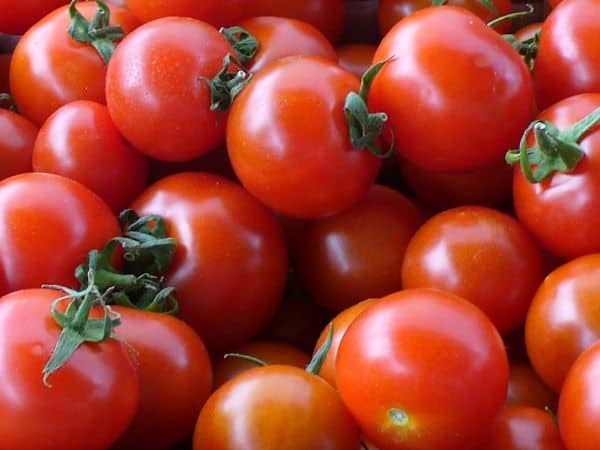
Nothing compares to the flavor of field ripened tomatoes in late summer – photo copyright by C. Cancler
August: blackberries, blueberries, corn, green beans, tomatoes
- To find a u-pick farm near you, use the Washington Farms | Local Farm Finder (eatlocalfirst.org)
Blackberries and similar berries* season usually peaks in August. Call u-pick blackberry farms in June or July for blackberry crop status. *Marionberry and Logan berry are two of the most popular varieties of blackberry. Tayberries and boysenberries are similar but different crosses between blackberries and raspberries.
- Roadside blackberry picking: You can pick the ubiquitous roadside blackberries found throughout the region in urban areas. There are two species you are likely to see. The Himalayan and the evergreen blackberry—both European species of blackberry. Some people have concerns about these “wild” berries, being either covered with automobile exhaust or possibly sprayed with a weed killer. Others state they are bland in flavor comparied to commercially grown varieties. But, many, many people pick and enjoy these “wild” berries.
- Wild berry picking: If you want a truly wild, native (and most claim a much better tasting) berry than the roadside variety without the expense of buying them from a farmer, consider a day hike to pick native wild berries, including blackberries, as well as blueberries, salmonberries, thimbleberries, and huckleberries. For advice and particulars, read this article from Washington Trails Association about Berry Picking Hikes (wta.org).
Blueberry season usually peaks in August. Call u-pick blueberry farms in June or July for blueberry crop status. There are many varieties of blueberries. I usually recommend you simply visit one or more farms, pick a few different varieties, and see which ones you prefer for your purpose whatever it may be from smoothies to muffins to pie.
Corn usually peaks in August or September. Call u-pick corn farms in June or July for crop status. If you go to the Washington State Fair in Puyallup, plan to stop at a roadside stand on your way. I’ve found prices about half of those at Seattle area farmers markets and produce stands. If you go before the Fair, be sure to bring a cooler along, rather than leave your produce in a hot car while you enjoy the Fair.
Green bean season usually peaks in August or September. Early in the year, you may want to inquire whether they offer yellow wax beans, purple beans, or other varieties such as Fava beans and shelling beans. Call u-pick green bean farms in June or July for green bean crop status, or a bit earlier if you want Fava beans.
Tomatoes usually peak in August and September. For u-pick, the goal is often a sauce or plum tomato, which is simply a variety that contains less water and seeds for more quickly turning into diced tomatoes, tomato sauce, tomato paste, marinara sauce, and other canned tomato products. The other basic type of tomato is the salad or slicing tomato, including cherry tomatoes; both are best eaten fresh. However, salad types can also be canned, but may produce thinner sauce or require longer cooking to thicken. Hybrid (newer varieties) as well as heirloom (old tomato varieties) may be either type. There are so many tomato varieties, my recommendation is to decide what you want to do with them (for example, put up canned tomato sauce) and ask the farmer for a recommendation from varieties they offer. Call u-pick tomato farms in July for crop status.
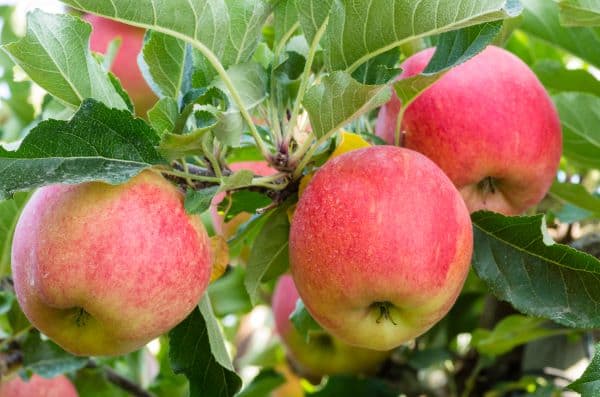
Washington State apples are known worldwide – DepositPhotos.com
September: apples, grapes, pears
- To find a u-pick farm near you, use the Washington Farms | Local Farm Finder (eatlocalfirst.org)
Apples peak in September and October. There are many, many varieties. Call u-pick apple orchards early in the year to inquire about varieties they offer and again in July or August for crop status. Again, I would encourage you to pick varieties you don’t know. There are many old-time varieties in the Pacific Northwest, originally planted in the late 18th and early 19th centuries. Many are worth discovering.
Grapes usually peak September. Call u-pick grape farms in August for crop status. Last time we checked, there were no u-pick, but there are several grape farms where you might be able to either buy grapes directly, or find out where and when they sell their crop.
Pears peak in September and October. Call u-pick pear orchards in July or August for crop status.
October: pumpkins, winter squash
- To find a u-pick farm near you, use the Washington Farms | Local Farm Finder (eatlocalfirst.org)
Halloween Pumpkins: Every September, we update our list of Where to find u-pick pumpkin patches and farm stands.
Winter squash and pie pumpkins (as opposed to pumpkins for Halloween jack-o-lanterns) peak in October. Call u-pick pie pumpkin farmers and u-pick winter squash farmers in August or September for crop status.
But wait, there’s more!
- Best discount grocery stores and bakery outlets
- Free (and cheap) cooking classes and food tours
- Farmers markets in the Puget Sound region
- Local CSA delivery from farms and other food producers
- Find free and cheap things to do every day on the Greater Seattle on the Cheap calendar.
- Visit the Greater Seattle on the Cheap home page and choose from a menu of free and cheap activities in the Puget Sound region.
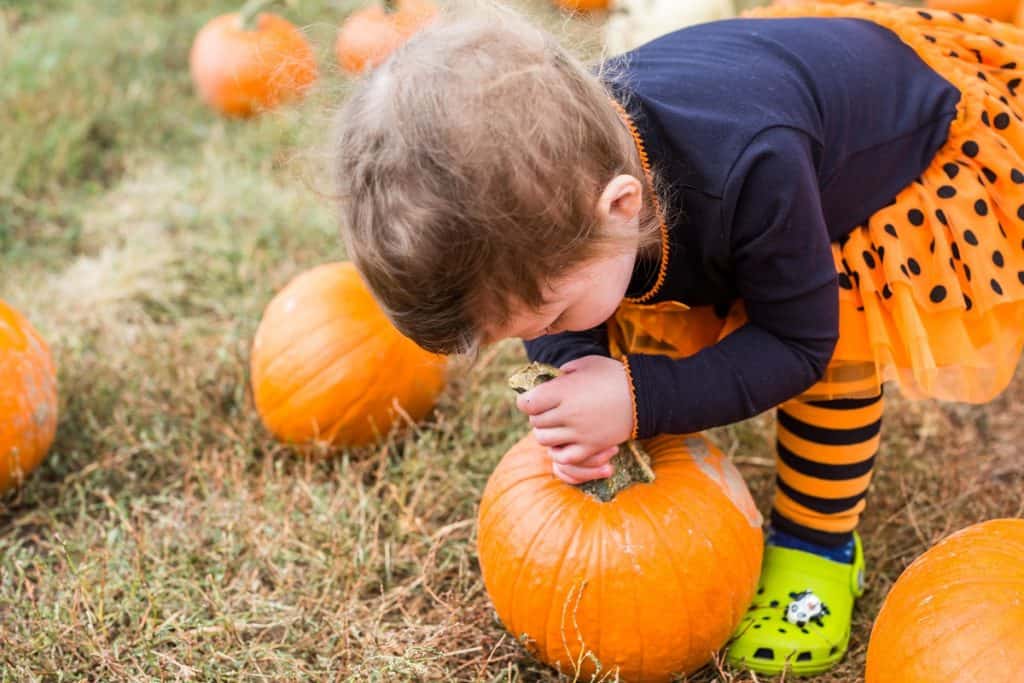
U-pick pumpkins are one of the easiest crops even for tiny hands – DepositPhotos.om
Upcoming Food & Beverage Events in the Puget Sound region
The calendar below includes all kinds of food and beverage festivals, tastings, tours, and many other food-related events on our calendar.
Puget Sound region





